A thin uniform conducting rod of mass M and length L oscillates in a vertical plane about a fixed horizontal axis passing through its top end. The rod is oscillating with angular amplitude θ0. A uniform horizontal magnetic field B, perpendicular to the plane of the oscillation is switched on.
(a) Calculate the maximum emf induced between the ends of the rod.
(b) If the rod has a finite thickness (any real life rod will definitely have a thickness), what difference in oscillation is expected in absence of magnetic field and in presence of magnetic field. Describe qualitatively.
The correct Answer is:(a) B2√3gL3(1−cosθ0)
(b) In presence of field the oscillations will die
Step by step video, text & image solution for A thin uniform conducting rod of mass M and length L oscillates in a vertical plane about a fixed horizontal axis passing through its top end. The rod is oscillating with angular amplitude theta_(0). A uniform horizontal magnetic field B, perpendicular to the plane of the oscillation is switched on. (a) Calculate the maximum emf induced between the ends of the rod. (b) If the rod has a finite thickness (any real life rod will definitely have a thickness), what difference in oscillation is expected in absence of magnetic field and in presence of magnetic field. Describe qualitatively. by Physics experts to help you in doubts & scoring excellent marks in Class 12 exams.
Topper's Solved these Questions
- BOOK - ARIHANTCHAPTER - ELECTROMAGNETIC INDUCTIONEXERCISE - Level 239videos
ELECTROMAGNETIC INDUCTION
- BOOK - ARIHANTCHAPTER - ELECTROMAGNETIC INDUCTIONEXERCISE - Level 312videos
ELECTROMAGNETIC INDUCTION
- BOOK - ARIHANTCHAPTER - CURRENT ELECTRICITYEXERCISE - Current Electricity105videos
CURRENT ELECTRICITY
- BOOK - ARIHANTCHAPTER - ELECTROSTATICSEXERCISE - Level 359videos
ELECTROSTATICS
Similar Questions
A metal rod of length 15×10−2m rotates about an axis passing through one end with a uniform angular velocity of 60 rad s−1. A uniform magnetic field of 0.1 Tesla exisits in the direction of the axis of rotationn. Calculate the EMF induced between the ends of the rod.
View SolutionCalculate the moment of inertia of a rod of mass M, and length l about an axis perpendicular to it passing through one of its ends.
View Solution
Knowledge Check
- Question 1 - Select One

A uniform rod of legth L is free to rotate in a vertica plane about a fixed horizontal axis through B. The rod begins rotating from rest. The angular velocity ω at angle θ is given asA√(6gL)sin(θ2)B√(6gL)cos(θ2)C√(6gL)sinθD√(6gL)cosθ - Question 2 - Select One
A uniform rod of mass m and length l rotates in a horizontal plane with an angular velocity ω about a vertical axis passing through one end. The tension in the rod at a distance x from the axis is
A12mω2xB12mω2(1−x2l)C12mω2l(1−x2l2)D12mω2l[1−xl] - Question 3 - Select One
A uniform metal rod is rotated in horizontal plane about a vertical axis passing through its end at uniform rate. The tension in the rod is
Asame at all pointsBdifferent at differen points and maximum at centre of rodCdifferent at different points and minimum at axis of rotation.Ddifferent at different points and maximum at axis of rotation
A uniform rod of length l oscillates about an axis passing through its end. Find the oscillation period and the reduced length of this pendulum.
View SolutionMoment of inertia of a thin rod of mass 'M' and length 'L' about the axis perpendicular to the rod and passing through its centre is ............
View SolutionA thin uniform rod of length l and mass m is swinging freely about a horizontal axis passing through its end. Its maximum angular speed is ω. Its centre of mass rises to a maximum height of -
View SolutionA thin uniform rod of length l and mass m is swinging freely about a horizontal axis passing through its end. Its maximum angular speed is ω. Its cenre of mass rises to a maximum height of :
View SolutionA conducting rod AB moves parallel to x-axis in a uniform magnetic field pointing perpendicular and into the plane of paper. The end A of the rod
 View Solution
View Solution

